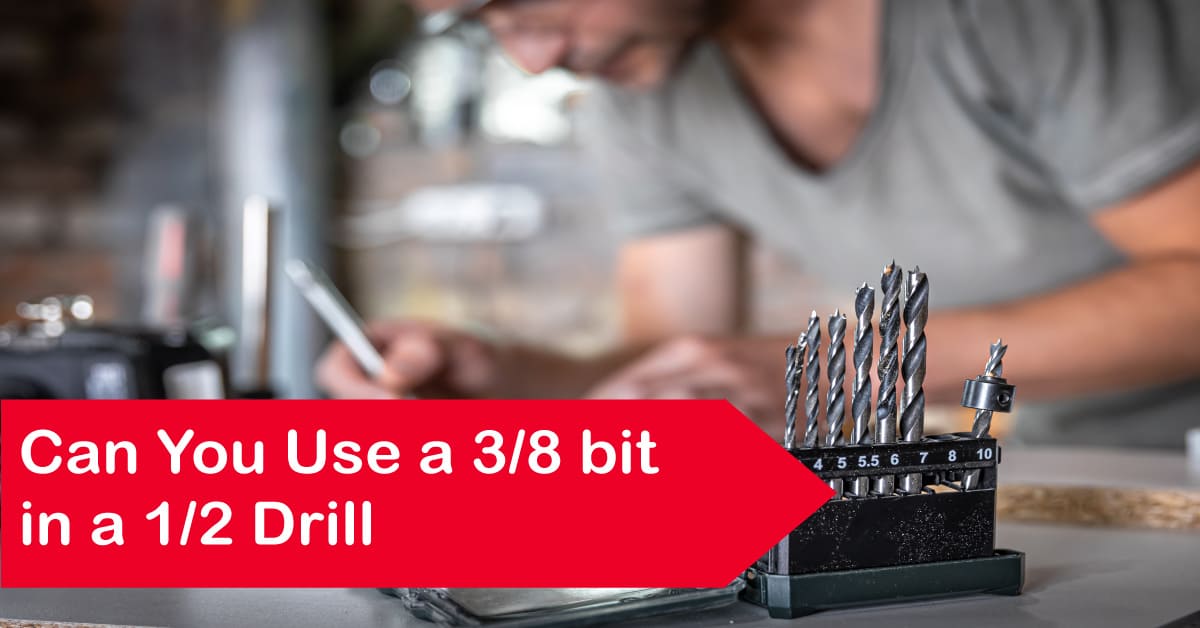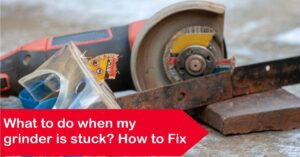Are you ready to debunk one of the most hyped questions in the world of woodworking? Brace yourself, because today I am diving into the exciting world of drill bits! The question on everyone’s mind is, “Can you use a 3/8 bit in a 1/2 drill?” Let’s clear the air right away: using a 3/8 drill’s bit in a 1/2 inches drill is a piece of cake.
Whether you are itching to turn your cordless drill into a corded one or simply like to relish a 3/8 drill bit’s optimal speed, you are in luck. Drills have a maximum bit size that they can fit, and that’s your guiding star when selecting the right drill for your projects. So, 3/8 inches drills will happily embrace bits up to 3/8 inches in size. The same goes for 1/2 inches drills. They can handle bits up to a size of ½ inches.
So, you can comfortably pop that 3/8 bit into your 1/2 drill without breaking a sweat. However, you need to be mindful of the differences between these two bits’ sizes and choose the right one for the job at hand. A 3/8 inches bit shines in smaller tasks, while a 1/2 inches bit is great when it comes to larger projects. Here, I will explore these two drill bits and uncover their similarities and differences.
Know The Similarities Between a 3/8 Inches Drill and a 1/2 Inches Drill
So, I have been observing these two drills, the 3/8 inches and the ½ inches, and I noticed some interesting similarities between them. First of all, they both work with both batteries and AC power, which makes them really versatile. Another thing I noticed is that they are both great for woodworking.
Also, even though they have different sizes, both the 1/2 inches drill and the 3/8 inches drill are designed to be handheld and portable. They are friendly tools that you can easily carry around and use wherever you need them.
What are the Differences Between These Two Drills?
These two drills might perform many tasks similarly. However, they differ in the cases of speed, torque, area of application, price, and durability. Let’s check out how they can differ:
3/8 Inches Drill
When it comes to torque, the 3/8″ drill may not be the superhero of power tools, but it still packs a punch! While it may have less torque compared to its counterparts, don’t let that fool you. This little dynamo can handle all your light-duty applications with ease. Need to tighten some screws or drill into softer materials?
The 3/8″ drill has got your back. It’s nimble, quick, and perfect for those tasks that don’t require Herculean strength. Speaking of speed, the 3/8″ drill zooms past its competitors in the swiftness department. Since it’s designed for less demanding jobs, it can rev up those RPMs and get the job done in a jiffy.
So, if you’re in a hurry or simply enjoy the thrill of speed, the 3/8″ drill is the speedy Gonzalez of the drill world. Now, let’s talk about durability. While it may not be as tough as its larger sibling, the 1/2″ drill, the 3/8″ drill still holds its own. It’s built to withstand the rigors of everyday use and won’t throw in the towel at the first sign of trouble.
Therefore, fear not, fellow DIYers and handypersons, the 3/8″ drill won’t leave you high and dry when you need it most. It’s a worthy investment that won’t crumble under pressure. And let’s not forget about everyone’s favorite topic: price. The 3/8″ drill wins in the affordability department as it is cheaper compared to the ½ inches drill.
With its reasonable price tag, you can enjoy the convenience and versatility of a drill without breaking the bank. And should the unexpected happen and your trusty 3/8″ drill needs replacing, it won’t burn a hole in your wallet. So, how should you make the most of this versatile tool? The 3/8″ drill is a DIY enthusiast’s dream come true.
From assembling furniture to tackling small household projects, it’s the perfect companion for all your DIY adventures. Need to hang a picture frame or install a curtain rod? The 3/8″ drill has got you covered. It’s also great for occasional jobs that pop up around the house, saving you from having to call in the professionals.
1/2 Inches Drill
The most common drills available right now on the market are the 1/2 inches drills. Let’s start with torque again, the powerhouse of the 1/2″ drill. When it comes to muscle, this drill takes the crown. With its impressive torque, it’s the go-to drill for tackling tough jobs and drilling through stubborn materials. But here’s the deal: With great power comes great responsibility.
Make sure to handle this beast with care, because you don’t want to get caught off guard by its mighty strength. Safety first, my friends! Now, let’s talk about speed. The 1/2″ drill may not zoom past its competitors like the more speedy 3/8″ drill, but hey, it’s got a good reason. The need for more torque calls for a slower pace. But guess what?
That slower speed gives you better control over the raw power at your fingertips. Durability is where the 1/2″ drill truly shines. Being a force to be reckoned with, it is built to last longer. You can expect this robust tool to outlast the 3/8 inches drill. Just remember, use it as recommended. Of course, with great durability comes a higher price tag. If you’re on a tight budget, the 1/2″ drill might seem a bit pricey.
But trust me, the investment is worth it. Sometimes, you have to pay a little more for exceptional quality. The ideal drill for professional work is a ½ inches drill. If you are engaged in heavy-duty construction or tackling serious projects, this is the drill you need by your side.
Its immense power and torque will make light work of even the most demanding tasks. Not only that but if you are in it for the long haul and require a drill that can handle prolonged use, the 1/2″ drill has got you covered. It’s designed to make your work easier and more efficient.
So, Can a 3/8 Inches Drill Bit Be Used in a ½ Inches Drill?
So, now after knowing their similarities and differences, you are probably wondering, “Can I use a 3/8″ bit in a 1/2″ drill?” Yes, you absolutely can! By popping a 3/8 bit into your 1/2 drill, you are not just expanding your drilling horizons, you are turbocharging your tool. It’s like giving your 1/2 drill a shot of espresso because the 3/8 bit kicks things into high gear.
And why does it do that? Well, the 3/8 bit is designed to work at lightning-fast speeds, making your woodworking tasks a breeze. Now, let’s address the elephant in the room – the drop in torque and durability. Sure, when you pair the 3/8 bit with your mighty 1/2 drill, you might experience a slight decrease in power.
But fear not, my friend, because you gain something even better – versatility. With the 3/8 bit in your 1/2 drill, you can tackle a wide range of projects like a pro. It’s like having a toolbox full of different-sized tools all in one place. Talk about convenience!
The possibilities are endless when you team up the 3/8 bit with your 1/2 drill. From drilling precise holes to countersinking, tapping, and reaming, this dynamic duo can handle it all. Polishing, sanding, and buffing can also be done with the appropriate attachments.
How Can You Use a 3/8 Bit in a 1/2 Drill?
Alright, listen up, drill enthusiasts! If you want to rock a 3/8 bit in your mighty 1/2 drill, here’s the lowdown on how to do it right. Get ready for some drilling magic! First things first, make sure that you align your 3/8 inches bit perfectly with your 1/2 inches drill. Precision is key here, folks! Once you have got that bit in place, apply just the right amount of pressure and slowly guide it forward.
Keep that bit in nice contact with the material you are drilling into, and let the drilling work begin! Oh, and don’t forget to adjust the pressure as needed to conquer that depth you’re aiming for. But hey, let’s be real here – caution is the name of the game when it comes to using a 3/8 bit in a 1/2 drill. Why, you ask?
Well, that smaller bit can be a sneaky little slipper, damaging the material you are drilling into. So, my friends, exercise caution, keep your eyes peeled, and take your time. If you’re not feeling like a confident drill maestro, it’s always wise to seek the advice of a pro or consider using a different bit size. Remember, the 3/8 bits are like the petite superheroes of the drilling world, perfect for smaller tasks.
On the other hand, the mighty 1/2 bits are the heavyweights, ready to tackle those larger jobs. However, if you are feeling adventurous and want to use a 3/8 drill bit in your 1/2 drill, then understand the differences between these two drills’ sizes, and exercise caution. If you are in doubt about which size bit you should use, consult the experts or read up on your handy manufacturer’s instructions.
Frequently Asked Questions (FAQs)
Can I use a 1/4 inches drill bit in a 3/8 inches drill?
Yes, you can use a 1/4 inches drill bit in a 3/8 inches drill. However, it is important to note that using a smaller drill bit in a larger drill may result in reduced stability and precision. Exercise caution and apply controlled pressure to prevent the bit from slipping or wandering off course. Consider consulting the drill manufacturer’s instructions for any specific recommendations or limitations regarding bit sizes.
Can you use a 3/4″ bit in a 1/2″ inch drill?
No, you can’t use a 3/4″ bit in a 1/2″ drill. The size of the drill bit should match the capacity of the drill chuck. A 3/4 inches drill bit cannot be held in the chuck of a 1/2 inches drill, as it is too small. It can cause damage to both the drill and the bit and may result in injury. So, it is essential to use the appropriate size drill bit for the drill to ensure safe and effective operation.
Are Drill Bits Universal?
No, drill bits are not universal. They come in various sizes, shapes, and materials to accommodate different types of drilling tasks and materials. The choice of drill bit depends on the specific application, such as drilling into wood, metal, concrete, or tile. In addition, the size of the hole required and the type of drilling equipment being used also affect the selection of drill bits.
Conclusion
Finally, I can say, the most typical drill bit on the market is a 3/8″ drill bit, and it fits in a 1/2″ drill. The only drawback to using a 3/8″ drill bit in a 1/2″ drill is that it will protrude more from the chuck compared to when you use a 1/2″ bit. Because of this longer protrusion, you must be careful not to cause damage to anything.
It is completely safe to use a 3/8″ drill bit in a 1/2″ drill, and in some cases, it may even be beneficial. I am hopeful that after reading this short yet informative article, you have gathered enough information on the topic: can you use a 3/8 bit in a 1/2 drill? To advance your woodworking abilities to a new level, make sure to utilize your own tools to the maximum extent possible!




